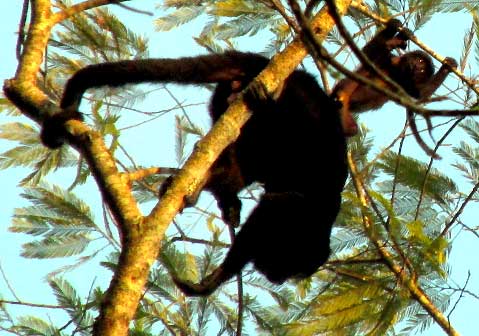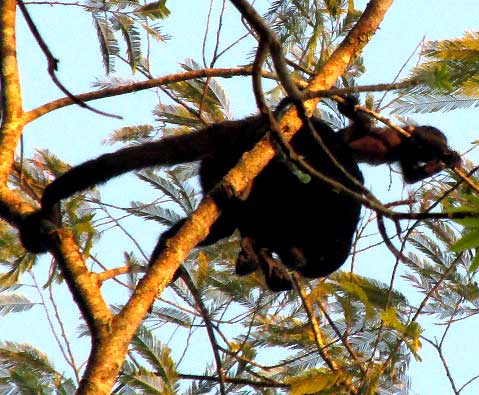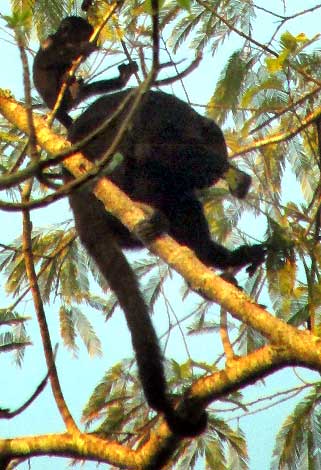Excerpts from Jim Conrad's
Naturalist Newsletter
from the April 6, 2019 Newsletter with notes from a camping trip into the Petén distric of northern GUATEMALA
HOWLER MONKEYS
At dawn on March 31 in the campground at El Rosario National Park on the west side of Sayaxché, Petén, as soon as it was light enough to properly see, a tremendous roar erupted from the woods beside my tent, then a couple of Howler Monkeys climbed into the upper branches of a tall Lysiloma acapulcensis tree almost above my tent. Below, you can see them on their ascent:

On previous camping trips I've photographed Spider Monkeys, which you can compare with the above Howler Monkey picture at www.backyardnature.net/yucatan/monkey.htm
Usually you hear Howler Monkeys, Alouatta pigra, but see Spider Monkeys, Ateles geoffroyi. This was the first time since I began issuing these Newsletters that Howler Monkeys got close enough to photograph, and I was tickled. In the above Howler picture, notice how the Howler's head is so much larger relative to the body than the Spider Monkey's. Much of the head size is the consequence of the big vocal pouch below the throat. Also notice how the Howler's tail and legs are shorter, less spidery, than the Spider's.
In the above picture, notice the hump on the lower monkey's back. At first I thought it might be some kind of tumor, but once the monkey stopped climbing suddenly the lump sprouted appendages and rose up, a moment caught in the photo below:

It's a baby monkey riding the mother's back, and what fun I had watching that baby work out its inner tensions, consisting of his uppers body wanting more than anything to latch onto tree limbs, chew on things and generally explore all aspects of limber tree limbs and feathery leaves, while his feet desperately wanted to hold onto mama. The mother from all appearances was paying no attention to the young one, seemingly fully confident that the kid could take care of himself. Below, another shot shows the young one leaning heavily on a stem, with the tail curled around it for extra security:

At one point it appeared that the young one detached from the mother, shown at below:

But that foray was brief, quickly returning to mama's back.
The monkeys stayed in the Lysiloma acapulcensis for about 20 minutes, before drifting on. They were so dark that I couldn't make out whether they ever put anything in their mouths. Maybe they'd just climbed up there to dry out in the morning's first sun rays.
Back in the mid 1970s I served as naturalist on river trips to see archaeological ruins in this area, including a memorable four-day mule-train trip to the recently discovered El Mirador ruins in the northern Petén. I'm pretty sure that back then the blood-curdling roars of Howler Monkeys were not nearly as commonly heard as they are now. Today only a small part of the vast Petén forest remains, and I suspect that now the roaring is more commonplace because large numbers of monkeys have been forced into a few small refuges. Possibly they roar more throughout the day because they're feeling pressure from neighboring groups and need to make clear that they mean to defend their little spot of the forest.
I know of a couple of "restore the Howler Monkey" projects in the area, but habitat continues to be destroyed.
MORE HOWLER MONKEY INFORMATION FROM THE NEXT WEEK'S NEWSLETTER:
All howler monkey species belong to the genus Alouatta. Currently 15 howler species are recognized, all tropical American, occurring from southern Mexico south through Central America and most of northern and central South America.
The species in our pictures from lowland northern Guatemala is ALOUATTA PIGRA, in English usually known as the Guatemalan Black Howler, occurring in Mexico's southern Yucatan Peninsula, the southern Mexican states of Chiapas and Tabasco, and Belize and Guatemala's lowland Petén district. Mexico's SEMARNAT classifies the species as endangered because of habitat destruction, hunting and the capturing of individuals for the pet trade.
A 2010 study by Laura Elisa Argüello and others, conducted in the Mexican state of Tabasco -- the paper freely downloadable in Spanish -- found that during an observation period of 67 hours a small group of Guatemalan Black Howlers spent 13% of their time feeding, 13% moving about, 73% resting, and the rest of the time playing and calling.
The large percentage of resting time reflects the fact that mainly these monkeys eat leaves, much more than fruits and other items such as flowers, buds, nuts, and sometimes bird eggs; they're classified as "folivores." When they rest, microbes in their guts are busily fermenting the otherwise hard-to-digest material.
The howlers' roars or howls can be heard clearly for three miles (4.8km), apparently helping groups space themselves, as well as to claim territory, and maybe to keep others away from their mates. Mostly they howl at dawn and dusk but also occasionally throughout the day.